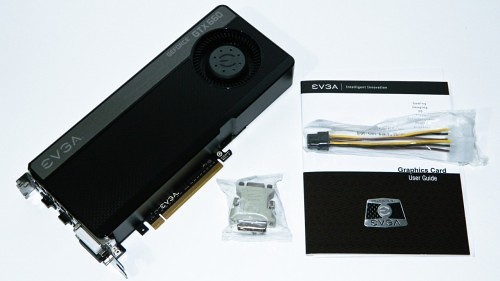What’s in the Box?
While the EVGA GTX 660 Ti ships from retailers with a copy of Borderlands 2, the GTX 660 does not. At least at this point before launch. It would be cool if all $199 and higher cards came with something that good.
What you do get is a well wrapped video card, VGA-DVI adapter, user’s manual, drivers disc, 4pin to 6pin PCIE cable adapter, and slick EVGA badge (centered low on the manual). All of which is likely to keep the highly competitive $199 price point in check.
Test System Configuration
Installing your video card, video drivers, and any extra software is all part of the user experience. In the past, we’ve had a couple large cards require some effort due to really large PCBs and over sized PCI brackets. Fortunately, the card installed easily. Driver version 306.23 (Win 7) worked well with the EVGA GTX 660 SC.
- Processor: Intel Core i7-3770K Ivy Bridge
- Motherboard: ASUS ROG Maximus V Gene
- Memory: Kingston HyperX 2800MHz DDR3 @ 1600 CL8
- Video Card 1: EVGA GTX 660 Superclocked (as tested)
- Video Card 2: MSI GTX 560 Ti Twin Frozr II
- Video Card 3: EVGA GTX 660 Ti SuperClocked
- Video Card 4: GIGABYTE GTX 670 OC Edition
- Power Supply: Antec High Current Pro 1000 Watt Platinum
- Cooling: NZXT HAVIK 140
- OS: Win 7 Pro 64-bit
We have chosen a system that is somewhat on the upper end of the Z77 chipset series, but is still realistic for a $199 GPU to inhabit. We test against GPUs directly below it and above it including a GPU that is double the price, namely, the GTX 670. This will give us a good idea of just how much value NVIDIA has given this GPU and how well it will serve gamers searching for a GPU in this price point.
Screen resolutions are set at 1920 x 1080p on an ASUS VG27H 3D monitor. Benchmark resolutions are in the graph details. Power consumption was monitored using a Seasonic Power Angel with a minimum of 1 hr observation time. Fan noise was recorded using an Extech sound meter which has a limited 30dB detection level. Therefore, fan noise was measured from 2 feet away so we could hear some difference.
Overclocking the GTX 660 EVGA’s Precision X
EVGA provides Precision X to work within NVIDIA’s Kepler algorithms. Like the GTX 660 Ti, a new blue GTX 660 skin was released to fit EVGA’s card. Users simply install Precision X, copy, and paste the skin to the proper folder. The utility offers all the settings needed to tune and to overclock the card. OC Scanner will test your overclock and card’s stability. If you don’t have an EVGA card but wished you had one, Precision X will still work with your GTX 660 from any other manufacturer.
Using Precision X, the voltage was maxed, fan set to 70%, and the card was able to achieve a 53MHz GPU clock offset and 215MHz memory offset. Temps remained below 80C so heat wasn’t the limiting factor. Fan noise was below 22dB during stock card operations. Overclocked, noise reached 36dB. This is all to be expected as EVGA naturally saves the premium GPU for their FTW series.
To get things going, let’s start the benchmarks off with our go to synthetic benchmarks: 3DMark11 and Unigine Heaven 3.0.
Synthetic 3D Performance Results
While 3DMark11 is a purely synthetic 3D benchmark, it does a decent job of placing GPUs within the field. What we see here is how the memory, active cores, and bit rate effect the overall output of the video card. Even though it’s slower than the 660 Ti SC, notice it’s surprisingly faster than the Fermi GTX 580. Overclocking the card affords about 200 more P score points.
The Heaven Demo is great for testing raw 3D performance. The surprise here is that the GTX 660 is only about 5 frames slower than the GTX 660 Ti. The Fermi cards just have all that extra bandwidth which helps them stay relevant. Still, not too shabby at all for the 660.
Now that we have some idea of how things should shake out, let’s see if the synthetic benchmarks are correct when dealing with real games!
Metro 2033
Although Metro 2033 is very dated now, it still continues to chew up the GTX 660 GPU resources which scored a surprising 28.6 fps while its big brother scores 30.1 fps. The results was repeatable. Whether stock or overclocked, the card still has some heart, and the best part is, it is within striking distance of a GPU nearly $100 more than it.
Speaking of age, it seems that GTX 580 still manages to hang in there on this older title. But we see a change coming up…
Let’s look at a few more benchmarks and take this review home.






